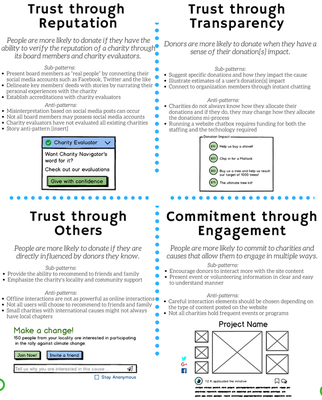Design Patterns: Help small non-profits build trust and engagement
 Image Creadit: method:CRM
Image Creadit: method:CRMOverview
My Role: UX Researcher in a team of five (5) researchers
Background/Context: Donors are often the core providers of a charity’s resource. Without donor support, some charities quickly struggle to function and are likely to enter a path of decline. Thus, it is important for charities to connect with their donors in order to gain their trust and increase their motivation.
Project Overview: I worked as part of a team to design best practices for facilitating online monetary donations to small charities and non-profits. Through interviews and analyses of established non-profit websites and their users’ behaviors and motivations, we developed design patterns allowing non-profit organizations to increase trust and engagement among donors.
Methods: Interviews, Competitive analysis, Design patterns, Literature review, and Desk research
Data Sources: Interview transcripts and Literature
Deliverables: Report describing research and suggested design patterns
Tools: Google Docs, Google Slides, and Google Forms
Table of Contents
Objective
- What stops a motivated user from making donations to small charities online?
- How can we convert a user’s motivation to donate to small charities online?
- How can help small charities design their online presence to establish trust and engagement?
Opportunity and Process
Opportunity
Most HCI research related to non-profits focuses on facilitating transparency in order to build trust among stakeholders (Marshall et al., 2016, 2018). However, there is still little understanding of how a non-profit’s website and its features impact donors’ motivation and engagement.
Process
We analyzed charity websites to understand the design processes they follow to convert user motivation into calls for action. We interviewed nine (9) donors to understand their perspectives on these websites. We focused our research on establishing online trust and engagement through better design.
We delved into the Persuasive Design literature and created design patterns that enhance the experience for millennials visiting small charitable websites. Effective design patterns translate research findings into executable solutions and assist web designers and developers. They contain:
- A concise and memorable title
- Statement[s] describing the problem or challenge
- Description and discussion on solving the problem
- Solutions that are likely to succeed
- Solutions that are typical yet undesirable
We identified impediments to charitable donations and recommended four design patterns that can help convert users’ motivation into action.
Strategy
Competitive Analysis
We analyzed websites of well-establish charities to explore different donation models, including WWF, UNICEF, Facebook Fundraisers, GoFundMe, etc.. We examined their user bases, information architectures, messaging approaches, calls to action, emotional designs, accreditations, and social influences. The competitive analysis provided us with key insights and informed our development of interview questions.
Interviews
We conducted interviews with nine (9) individual participants who either were active online donors or had donated through the above websites. The interviews highlighted the aspects that either motivated or discouraged donors as they navigated through the charity website. After our interviews, we inferred a relatively comprehensive list of statements taking the form “a person donates if he or she…”. We synthesized these statements into more general themes relevant to donors’ motivations.
Persuasive Design
 We followed Fogg’s behavior model for persuasion to guide our designs. The behavior model highlights three factors relevant to accomplishing target behavior - motivation, ability to perform, and trigger.
We followed Fogg’s behavior model for persuasion to guide our designs. The behavior model highlights three factors relevant to accomplishing target behavior - motivation, ability to perform, and trigger.
There is some debate about the ethics of designing charity websites with the sole intention of encouraging people to donate their money. However, our goal in creating design patterns was not simply to persuade people to donate:
- We wanted to leverage persuasive design for potential donors that already have medium levels of motivation but are missing ability and triggers to act on it.
- We wanted to understand what discourages motivated people from performing actions related to donations in online platforms and how HCI can help address these aspects.
Outcome
Importance of trust
- Trust is often critical when converting charitable motivations to actions
- Monotonous, one-way interactions do not help donors help engaged or fulfilled
Suggested patterns
Our design patterns were concise and memorable with explicit descriptions of the relevant problems and common pitfalls that should be avoided.
The patterns that emerged were “Trust through reputation”, “Trust through transparency”, “Trust through social circle”, and “Commitment through Engagement”.

Conclusion/Reflection
In this project, we conducted competitive analysis and interviews and analyzed user behavior/motivations pertaining to charities. We developed design patterns for non-profits seeking to increase trust and engagement among donors.
In the future, we hope to create additional design patterns incorporating other factors that are useful when designing a successful non-profit website (e.g. social media marketability, attractiveness to volunteers, etc.). These additional design patterns would eventually form a pattern language useful for converting different users’ motivations into actions furthering the non-profits’ overarching goals.